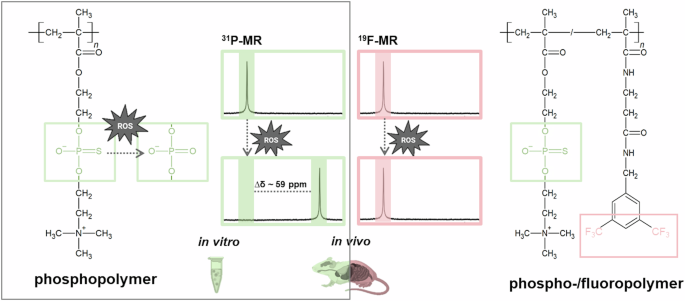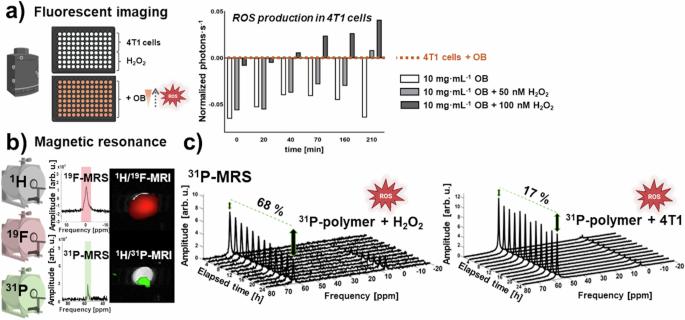Bio-responsive polymers for dual 31P/19F-magnetic resonance to detect reactive oxygen species in vivo
IF 7.5
Q1 MATERIALS SCIENCE, MULTIDISCIPLINARY
引用次数: 0
Abstract
Biocompatible metal-free agents are emerging as a promising alternative to commercial magnetic resonance (MR) contrast agents, but there is an additional need for novel probes with enhanced responsiveness in preclinical MR testing to effectively target diverse pathological conditions. To address this, we develop hydrophilic phospho-/fluoropolymers as dual MR probes. Incorporating thiophosphoester groups (P = S) into the polymer structure produces a distinct chemical shift (~59 ppm) in phosphorus MR (31P-MR), reducing biological signals interference. Reactive oxygen species (ROS) oxidize the P = S groups, causing a detectable shift in 31P-MR, enabling precise localization of ROS, abundant in inflammation and cancer. To enhance this capability, bioinert trifluoromethyl groups (CF3) are added, creating a “hotspot” for fluorine MR (19F-MR), aiding in vivo localization. Both in vitro and in vivo testing demonstrate the probe’s high specificity and responsiveness, underscoring its potential as a sensitive ROS sensor and dual MR-traceable tool in cancer research. Magnetic resonance imaging lack biocompatible metal-free contrast agents with specific functionality. Here, hydrophilic phospho-/fluoropolymers are developed as 31P/ 19 F-MR probes for in vivo detection of reactive oxygen species.


用于 31P/19F 双磁共振检测体内活性氧的生物响应聚合物
生物相容的无金属制剂正在成为商用磁共振(MR)造影剂的一种前景广阔的替代品,但临床前磁共振测试中还需要响应性更强的新型探针,以有效针对不同的病理状况。为此,我们开发了亲水性磷/氟聚合物作为双重磁共振探针。在聚合物结构中加入硫代磷酸酯基团(P = S)可在磷磁共振(31P-MR)中产生明显的化学位移(约 59 ppm),从而减少生物信号干扰。活性氧(ROS)会氧化 P = S 基团,导致 31P-MR 发生可检测到的位移,从而实现对在炎症和癌症中大量存在的 ROS 的精确定位。为了增强这种能力,添加了生物惰性的三氟甲基(CF3),形成氟磁共振(19F-MR)的 "热点",有助于体内定位。体外和体内测试都证明了该探针的高特异性和高响应性,凸显了它作为灵敏的 ROS 传感器和双重磁共振可追踪癌症研究工具的潜力。磁共振成像缺乏具有特定功能的生物相容性无金属造影剂。在此,我们开发了亲水性磷/氟聚合物作为 31P/ 19 F-MR 探针,用于体内检测活性氧。
本文章由计算机程序翻译,如有差异,请以英文原文为准。
求助全文
约1分钟内获得全文
求助全文
来源期刊

Communications Materials
MATERIALS SCIENCE, MULTIDISCIPLINARY-
CiteScore
12.10
自引率
1.30%
发文量
85
审稿时长
17 weeks
期刊介绍:
Communications Materials, a selective open access journal within Nature Portfolio, is dedicated to publishing top-tier research, reviews, and commentary across all facets of materials science. The journal showcases significant advancements in specialized research areas, encompassing both fundamental and applied studies. Serving as an open access option for materials sciences, Communications Materials applies less stringent criteria for impact and significance compared to Nature-branded journals, including Nature Communications.
 求助内容:
求助内容: 应助结果提醒方式:
应助结果提醒方式:


